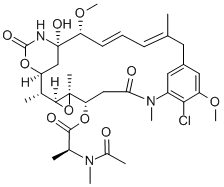Maytansine manufacturers
- Maytansine
-

- $10.00 / 1Kg/Bag
-
2021-08-31
- CAS:35846-53-8
- Min. Order: 1Kg/Bag
- Purity: 99%min
- Supply Ability: 2000
- maytansine
-

- $15.00 / 1KG
-
2021-07-13
- CAS:35846-53-8
- Min. Order: 1KG
- Purity: 99%+ HPLC
- Supply Ability: Monthly supply of 1 ton
Related articles - What is Maytansine?
- Maytansine is an important antineoplastic and antimicrobial compound with high cytotoxicity.
- Sep 7,2023
|
| | Maytansine Basic information |
| Product Name: | Maytansine | | Synonyms: | maitansine;Maytansine;NSC 153858;(14S,16S,32S,33S,2R,4S,10E,12E,14R)-86-Chloro-14-hydroxy-85,14-dimethoxy-33,2,7,10-tetramethyl-12,6-dioxo-7-aza-1(6,4)-oxazinana-3(2,3)-oxirana-8(1,3)-benzenacyclotetradecaphane-10,12-dien-4-yl N-acetyl-N-methyl-L-alaninate;Maitansina;Microtubule/Tubulin,tumor,mitotic,microtubule-targeted,arrest,Inhibitor,potent,subnanomolar,Maytansine,inhibit | | CAS: | 35846-53-8 | | MF: | C34H46ClN3O10 | | MW: | 692.2 | | EINECS: | 252-754-7 | | Product Categories: | | | Mol File: | 35846-53-8.mol |  |
| | Maytansine Chemical Properties |
| Melting point | 183.5-184℃ | | alpha | D26 -145° (c = 0.055 in chloroform) | | Boiling point | 895.1±65.0 °C(Predicted) | | density | 1.1049 (rough estimate) | | refractive index | 1.6000 (estimate) | | storage temp. | Store at -20°C | | solubility | DMF: 1 mg/ml; DMSO: 10 mg/ml; Ethanol: 2 mg/ml; PBS (pH 7.2): insol | | form | A solid | | pka | 9.82±0.70(Predicted) | | Stability: | Light Sensitive | | InChIKey | WKPWGQKGSOKKOO-YHBUUTGONA-N |
| Toxicity | LD50 in rats (mg/kg): 0.48 s.c. (Mugera, Ward) |
| | Maytansine Usage And Synthesis |
| Description | This novel ansa macrolide alkaloid occurs in a number of May tan us species. The
structure given has been elucidated from chemical and spectroscopic data. In low
doses (25-50 mcg/kg), maytansine prolonged the survival of mice bearing
vincristine-sensitive P388 leukemia but not those bearing vincristine-resistant
tumour lines. In vitro, it suppressed the growth of U21 0, LSl78Y and P388
leukemia cells with ED50 of 2 X 10-9 , 1.5 X 10-9 and 6 X 10-10M respectively and
elevated the mitotic index in L 121 0 cells. From labelling studies it was shown
that the alkaloid inhibited DNA formation by P388 cells to a greater extent than
RNA and protein synthesis. Maytensine did not inhibit RNA polymerase from
Escherichia coli at levels as high as 1 X 10-4M. | | Uses | Antineoplastic. | | Definition | ChEBI: An organic heterotetracyclic compound and 19-membered macrocyclic lactam antibiotic originally isolated from the Ethiopian shrub Maytenus serrata but also found in other Maytenus species. It exhibits cytotoxicity against many tumo
r cell lines. | | Biological Functions | Maytansine is a potent microtubule-targeted compound that inhibits proliferation of cells at mitosis. Antibody-maytansinoid conjugates consisting of maytansinoids (DM1 and DM4) attached to tumor-specific antibodies have shown promising clinical results The microtubule-targeting maytansinoids accumulate in cells and induce mitotic arrest at 250- to 1000-fold lower concentrations than those required for their association with tubulin or microtubules. | | Toxicology | Maytansine, an ansa macrolide isolated from African plants of the genera Maytenus and Putterlickia was first described almost two decades ago. It had been reported to be active against several forms of cancer, but a later phase II evaluation suggested no major role for this drug in tumor treatment. Although the toxic side effects were moderate, the antitumor activity was also not impressive.
Maytansine binds to tubulin rapidly and reversibly. Competitive inhibition of binding between maytansine and the vinca alkaloids has been observed, suggesting that maytansine must occupy at least one of vinblastine's binding sites on the tubulin molecule. The number of the maytansine binding sites is not known. Assembly of MT is inhibited at maytansine concentrations below 1μM. This suggests a substoichiometric poisoning mechanism as in the cases of colchicine, vinblastine and podophyllotoxin, but the details are not known. In contrast to many other MT-interacting toxins,maytansine does not promote the formation of aberrant tubulin polymers, even at millimolar concentrations. In fact, low concentrations of maytansine even inhibit vinblastine-induced formation of aberrant polymers. | | Mode of action | Maytansine is a new drug undergoing clinical investigation. It has functional similarities to vincristine.
Maytansine, an ansa macrolide of considerable antitumor potency, is obtained from plants of the genera Maytenus and Putterlickia. Maytansine binds rapidly and reversibly to tubulin, and is a competitive inhibitor of vinca alkaloid binding. Colchicine has no effect on maytansine binding. Maytansine and the vinca alkaloids have comparable binding constants, share a common binding site, although an additional site or attachment position specific for maytansine appears to be present. Maytansine may inhibit tubulin polymerization by interfering with certain critical-SH groups necessary for assembly. Like the vincas, it inhibits assembly substroichiometric. Unlike the vincas, as well as colchicine and podophyllotoxin, maytansine appears capable of inducing rapid microtubule disassembly in vitro when added to microtubules at end state. Furthermore, maytansine enhances alkylation by iodoacetamide,an effect opposite to that obtained with V BL, suggesting that maytansine may have different conformation effects on tubulin. | | References | Walpert-Defillipes et al., Biochem. Pharmacol., 24, 751 (1975) |
| | Maytansine Preparation Products And Raw materials |
| Raw materials | Maytansine, 3-O-de[2-(acetylmethylamino)-1-oxopropyl]-4,5-deepoxy-4,5-didehydro-, (4E)- (9CI)-->Spiro[2-azabicyclo[16.3.1]docosa-1(22),6,13,15,18,20-hexaene-11,2'-[1,3]dithian]-3-one, 21-chloro-5-[[(1,1-dimethylethyl)dimethylsilyl]oxy]-9-hydroxy-12,20-dimethoxy-2,6,8,16-tetramethyl-, [5S-(5R*,6E,8R*,9R*,12S*,13E,15E)]- (9CI)-->Maytansine, 3-O-de[2-(acetylmethylamino)-1-oxopropyl]-4,5-deepoxy-4,5-didehydro-9-O-methyl-, (4E)- (9CI)-->Maytansine, 3-O-de[2-(acetylmethylamino)-1-oxopropyl]-4,5-deepoxy-4,5-didehydro-3-O-[(1,1-dimethylethyl)dimethylsilyl]-, (4E)- (9CI)-->Spiro[2-azabicyclo[16.3.1]docosa-1(22),6,13,15,18,20-hexaene-11,2'-[1,3]dithian]-3-one, 9-[(aminocarbonyl)oxy]-21-chloro-5-[[(1,1-dimethylethyl)dimethylsilyl]oxy]-12,20-dimethoxy-2,6,8,16-tetramethyl-, [5S-(5R*,6E,8R*,9R*,12S*,13E,15E)]- (9CI) |
|